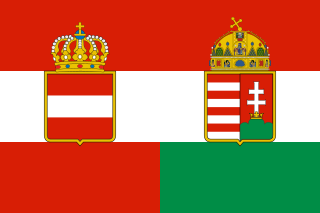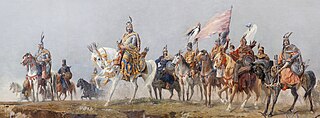
Austria-Hungary, often referred to as the Austro-Hungarian Empire or the Dual Monarchy, was a constitutional monarchy and great power in Central and Eastern Europe between 1867 and 1918. It was formed with the Austro-Hungarian Compromise of 1867, and was dissolved following the First World War.

The Central Powers, also Central Empires, consisting of Germany, Austria-Hungary, the Ottoman Empire and Bulgaria - hence also known as the Quadruple Alliance —was one of the two main coalitions that fought World War I (1914–18).

Hungary is a country in Central Europe. Spanning 93,030 square kilometres (35,920 sq mi) in the Carpathian Basin, it borders Slovakia to the north, Ukraine to the northeast, Romania to the east and southeast, Serbia to the south, Croatia and Slovenia to the southwest, and Austria to the west. With about 10 million inhabitants, Hungary is a medium-sized member state of the European Union. The official language is Hungarian, which is the most widely spoken Uralic language in the world, and among the few non-Indo-European languages to be widely spoken in Europe. Hungary's capital and largest city is Budapest; other major urban areas include Debrecen, Szeged, Miskolc, Pécs, and Győr.

The House of Habsburg, also officially called the House of Austria, was one of the most influential and distinguished royal houses of Europe. The throne of the Holy Roman Empire was continuously occupied by the Habsburgs from 1438 until their extinction in the male line in 1740 and after the death of Francis I from 1765 until 1806 after the dissolution of the Holy Roman Empire. The house also produced kings of Bohemia, Hungary, Croatia, Galicia, Portugal and Spain with their respective colonies, as well as rulers of several principalities in the Netherlands and Italy and emperors of Austria, Austria-Hungary and Mexico. From the 16th century, following the reign of Charles V, the dynasty was split between its Austrian and Spanish branches. Although they ruled distinct territories, they nevertheless maintained close relations and frequently intermarried.

Hungarian is a Uralic language spoken in Hungary and parts of several neighbouring countries. It is the official language of Hungary and one of the 24 official languages of the European Union. Outside Hungary it is also spoken by communities of Hungarians in the countries that today make up Slovakia, western Ukraine (Subcarpathia), central and western Romania (Transylvania), northern Serbia (Vojvodina), northern Croatia and northeastern Slovenia.

Slovakia, officially the Slovak Republic, is a landlocked country in Central Europe. It is bordered by Poland to the north, Ukraine to the east, Hungary to the south, Austria to the southwest, and the Czech Republic to the northwest. Slovakia's territory spans about 49,000 square kilometres (19,000 sq mi) and is mostly mountainous. The population is over 5.6 million and consists mostly of ethnic Slovaks. The capital and largest city is Bratislava, and the second-largest city is Košice. The official language is Slovak.

Transylvania is a historical region which is located in central Romania. Bound on the east and south by its natural borders, the Carpathian mountain range, historical Transylvania extended westward to the Apuseni Mountains. The term sometimes encompasses not only Transylvania proper, but also parts of the historical regions of Crișana and Maramureș, and occasionally the Romanian part of Banat.

Budapest is the capital and the most populous city of Hungary, and the ninth-largest city in the European Union by population within city limits. The city has an estimated population of 1,752,286 over a land area of about 525 square kilometres. Budapest is both a city and county, and forms the centre of the Budapest metropolitan area, which has an area of 7,626 square kilometres and a population of 3,303,786, comprising 33% of the population of Hungary.

Franz Josef I or Francis Joseph I was Emperor of Austria, King of Hungary, King of Croatia, King of Bohemia, and monarch of many other states of the Austro-Hungarian Empire, from 2 December 1848 until his death. From 1 May 1850 to 24 August 1866 he was also President of the German Confederation. He was the longest-reigning Emperor of Austria and King of Hungary, as well as the fourth-longest-reigning monarch of any country in European history, after Louis XIV of France, Johann II of Liechtenstein, and Elizabeth II of the United Kingdom, Canada, Australia, and New Zealand, in descending chronological order.

The Treaty of Trianon was one of the five major peace treaties prepared at the Paris Peace Conference and signed in Trianon on June 4, 1920, which formally ended World War I between most of the Allies of World War I and the Kingdom of Hungary, the latter being one of the successor states to Austria-Hungary. The treaty regulated the status of an independent Hungarian state and defined its borders. It left Hungary as a landlocked state that covered 93,073 square kilometres (35,936 sq mi), 28% of the 325,411 square kilometres (125,642 sq mi) that had constituted the pre-war Kingdom of Hungary. Its population was 7.6 million, 36% of the pre-war kingdom's population of 20.9 million. The areas that were allocated to neighbouring countries in total had a majority of non-Hungarians but 31% of Hungarians were left outside of post-Trianon Hungary. Five of the pre-war kingdom's ten largest cities were drawn into other countries. The treaty limited Hungary's army to 35,000 officers and men, and the Austro-Hungarian Navy ceased to exist.

The Hungarian Revolution of 1956, or the Hungarian Uprising, was a nationwide revolution against the Hungarian People's Republic and its Soviet-imposed policies, lasting from 23 October until 10 November 1956. Leaderless at the beginning, it was the first major threat to Soviet control since the Red Army drove Nazi Germany from its territory at the End of World War II in Europe.
The Hungary national football team represents Hungary in men's international football and it's controlled by the Hungarian Football Federation, The team has made nine appearances in the FIFA World Cup finals and 3 appearances in the European Championship, The team plays its home matches at the Puskás Aréna that opened in November 2019.

Viktor Mihály Orbán is a Hungarian politician who has been Prime Minister of Hungary since 2010; he was also Prime Minister from 1998 to 2002. He has also been President of Fidesz, a national conservative political party, since 1993, with a brief break between 2000 and 2003.

The Kingdom of Hungary was a monarchy in Central Europe that existed from the Middle Ages into the 20th century. The Principality of Hungary emerged as a Christian kingdom upon the coronation of the first king Stephen I at Esztergom around the year 1000; his family led the monarchy for 300 years. By the 12th century, the kingdom became a European middle power within the Western world.

Habsburg Monarchy is an umbrella term used by historians for the numerous lands and kingdoms of the Habsburg dynasty, especially for those of the Austrian line. Although from 1438 until 1806 a member of the House of Habsburg was also Holy Roman Emperor, the Empire itself is not considered a part of the Habsburg Monarchy.

World War I, also known as the First World War or the Great War, was a global war originating in Europe that lasted from 28 July 1914 to 11 November 1918. Contemporaneously described as "the war to end all wars", it led to the mobilisation of more than 70 million military personnel, including 60 million Europeans, making it one of the largest wars in history. It is also one of the deadliest conflicts in history, with an estimated nine million combatant and seven million civilian deaths as a direct result of the war, while resulting genocides and the related 1918 influenza pandemic caused another 17–50 million deaths worldwide.

The Hungarian People's Republic was a one-party socialist republic from 20 August 1949 to 23 October 1989. It was governed by the Hungarian Socialist Workers' Party, which was under the influence of the Soviet Union. Pursuant to the 1944 Moscow Conference, Winston Churchill and Joseph Stalin had agreed that after the war Hungary was to be included in the Soviet sphere of influence. The HPR remained in existence until 1989, when opposition forces brought the end of communism in Hungary.

Hungarians, also known as Magyars, are a nation and ethnic group native to Hungary and historical Hungarian lands who share a common ancestry, culture, history and language. Hungarian belongs to the Uralic language family. There are an estimated 14.2–14.5 million ethnic Hungarians and their descendants worldwide, of whom 9.6 million live in today's Hungary. About 2.2 million Hungarians live in areas that were part of the Kingdom of Hungary before the Treaty of Trianon and are now parts of Hungary's seven neighbouring countries, Slovakia, Ukraine, Romania, Serbia, Croatia, Slovenia and Austria. Significant groups of people with Hungarian ancestry live in various other parts of the world, most of them in the United States, Canada, Germany, France, the United Kingdom, Brazil, Australia, and Argentina.
Hungary in its modern (post-1946) borders roughly corresponds to the Great Hungarian Plain . During the Iron Age, it was at the boundary of Celtic, Illyrian and Iranian (Scythian) cultural spheres.

The first cases of the 2019–20 coronavirus pandemic in Hungary were announced on 4 March 2020. The first coronavirus-related death was announced on 15 March on the government's official website.


















